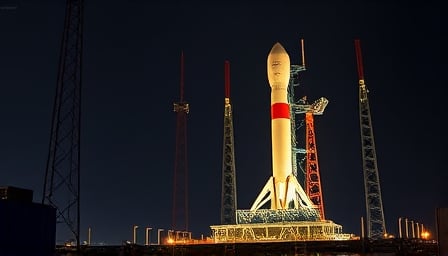Firefly Aerospace Inc.: A Critical Assessment of Current Trajectory
The space‑sector’s newest contender, Firefly Aerospace Inc. (NASDAQ: FLY), is poised to deliver its second‑quarter 2025 financial results on September 22, 2025. Analysts and investors alike have been watching the company’s performance metrics with increasing skepticism, given the stark contrast between its ambitious launch portfolio and its financial health.
1. Market Snapshot
| Item | Value |
|---|---|
| Closing price (16 Sep 2025) | $43.36 |
| 52‑week high | $73.80 |
| 52‑week low | $41.57 |
| Market capitalization | $6.89 billion |
| Price‑to‑earnings ratio | –23.11 |
The negative P/E figure is a red flag: it signals that Firefly is not yet generating sustainable earnings and, more broadly, that the market has priced in substantial future risk. The stock’s recent volatility—fluctuating between $41.57 and $73.80—underscores the uncertainty surrounding its growth prospects.
2. Product Portfolio and Flight Heritage
Firefly’s core offerings revolve around two launch vehicles and a suite of spacecraft:
- Alpha – a U.S.‑based, 1,000‑kilogram class orbital rocket that has completed four launches. Alpha’s performance data are publicly available and demonstrate a respectable success rate, but the limited launch cadence hampers revenue generation.
- Eclipse – a reusable, scaled‑up version of Alpha. While reusable technology promises cost reductions, the company has yet to deliver a successful flight, leaving the market doubtful of its viability.
- Blue Ghost Lander – a highly maneuverable lander built on the same propulsion technologies as Alpha and Eclipse, intended for lunar missions. The vehicle’s design leverages common hardware, but no operational payloads have yet validated its capabilities.
- Elytra – a spacecraft solution that, like Blue Ghost, relies on high‑performance rocket engines. Its market potential remains speculative, given the lack of confirmed contracts.
These vehicles showcase Firefly’s “common‑technology” strategy, aiming to reduce development costs and accelerate deployment. However, the lack of a diversified launch cadence and the absence of proven revenue streams from these platforms raise questions about the company’s ability to monetize its technological assets.
3. Financial Outlook Ahead of the Q2 Announcement
Firefly’s impending Q2 release will be a decisive moment. Investors will scrutinize:
- Revenue growth: Has the company secured additional commercial or government contracts beyond the existing Alpha launches?
- Cost structure: Is the company effectively managing R&D and manufacturing expenses, especially in light of its reusable vehicle development?
- Cash burn: Given its market cap, how long can the company sustain operations without additional financing?
Historical data suggest that space‑launch companies often require substantial capital infusion before achieving profitability. Firefly’s current market valuation reflects this reality, but the negative earnings metric signals that the company is far from breaking even.
4. Strategic Risks and Opportunities
| Risk | Impact | Mitigation |
|---|---|---|
| Launch delays | High | Accelerate testing, secure launch contracts |
| Technology failure | High | Leverage common platform, conduct rigorous QA |
| Funding constraints | Medium | Pursue venture capital, government grants |
| Competitive pressure | Medium | Differentiate with reusable technology and lander capabilities |
Conversely, Firefly’s potential to secure government contracts—particularly for national security and defense missions—could provide a steady revenue base. The company’s emphasis on “mission solutions” to national security customers positions it to tap into the U.S. defense budget, which is increasingly directed toward space capabilities.
5. Conclusion
Firefly Aerospace Inc. remains a high‑risk, high‑potential venture. Its ambitious product lineup and focus on reusable launch technology are laudable, yet the company’s current financial metrics and limited launch history paint a cautious picture. The forthcoming Q2 2025 results will be critical in determining whether Firefly can transition from a technology demonstrator to a commercially viable launch provider. Stakeholders should brace for a potentially turbulent period, while recognizing that the company’s innovative approach could, if executed flawlessly, redefine cost structures in the commercial space sector.
